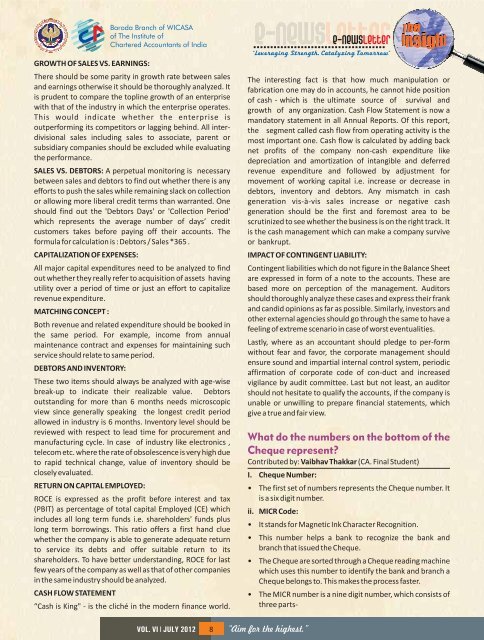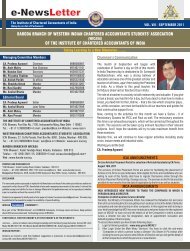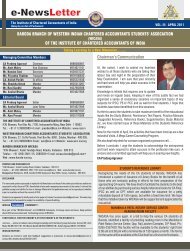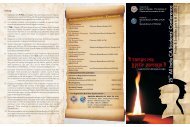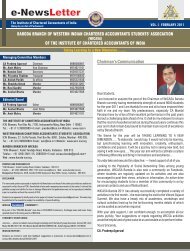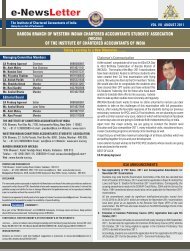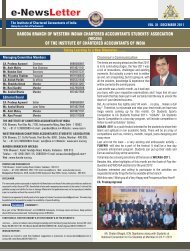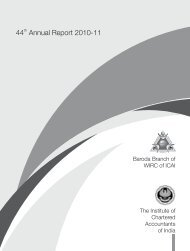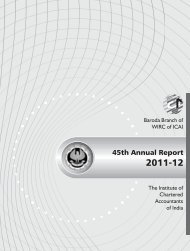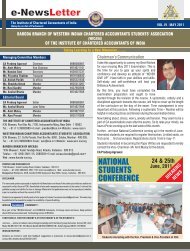e-NewsLetter e-NewsLetter - Baroda Branch of WIRC of ICAI
e-NewsLetter e-NewsLetter - Baroda Branch of WIRC of ICAI
e-NewsLetter e-NewsLetter - Baroda Branch of WIRC of ICAI
Create successful ePaper yourself
Turn your PDF publications into a flip-book with our unique Google optimized e-Paper software.
GROWTH OF SALES VS. EARNINGS:<br />
<strong>Baroda</strong> <strong>Branch</strong> <strong>of</strong> WICASA<br />
<strong>of</strong> The Institute <strong>of</strong><br />
Chartered Accountants <strong>of</strong> India<br />
There should be some parity in growth rate between sales<br />
and earnings otherwise it should be thoroughly analyzed. It<br />
is prudent to compare the topline growth <strong>of</strong> an enterprise<br />
with that <strong>of</strong> the industry in which the enterprise operates.<br />
This would indicate whether the enterprise is<br />
outperforming its competitors or lagging behind. All interdivisional<br />
sales including sales to associate, parent or<br />
subsidiary companies should be excluded while evaluating<br />
the performance.<br />
SALES VS. DEBTORS: A perpetual monitoring is necessary<br />
between sales and debtors to find out whether there is any<br />
efforts to push the sales while remaining slack on collection<br />
or allowing more liberal credit terms than warranted. One<br />
should find out the 'Debtors Days' or 'Collection Period'<br />
which represents the average number <strong>of</strong> days’ credit<br />
customers takes before paying <strong>of</strong>f their accounts. The<br />
formula for calculation is : Debtors / Sales *365 .<br />
CAPITALIZATION OF EXPENSES:<br />
All major capital expenditures need to be analyzed to find<br />
out whether they really refer to acquisition <strong>of</strong> assets having<br />
utility over a period <strong>of</strong> time or just an effort to capitalize<br />
revenue expenditure.<br />
MATCHING CONCEPT :<br />
Both revenue and related expenditure should be booked in<br />
the same period. For example, income from annual<br />
maintenance contract and expenses for maintaining such<br />
service should relate to same period.<br />
DEBTORS AND INVENTORY:<br />
These two items should always be analyzed with age-wise<br />
break-up to indicate their realizable value. Debtors<br />
outstanding for more than 6 months needs microscopic<br />
view since generally speaking the longest credit period<br />
allowed in industry is 6 months. Inventory level should be<br />
reviewed with respect to lead time for procurement and<br />
manufacturing cycle. In case <strong>of</strong> industry like electronics ,<br />
telecom etc. where the rate <strong>of</strong> obsolescence is very high due<br />
to rapid technical change, value <strong>of</strong> inventory should be<br />
closely evaluated.<br />
RETURN ON CAPITAL EMPLOYED:<br />
ROCE is expressed as the pr<strong>of</strong>it before interest and tax<br />
(PBIT) as percentage <strong>of</strong> total capital Employed (CE) which<br />
includes all long term funds i.e. shareholders' funds plus<br />
long term borrowings. This ratio <strong>of</strong>fers a first hand clue<br />
whether the company is able to generate adequate return<br />
to service its debts and <strong>of</strong>fer suitable return to its<br />
shareholders. To have better understanding, ROCE for last<br />
few years <strong>of</strong> the company as well as that <strong>of</strong> other companies<br />
in the same industry should be analyzed.<br />
CASH FLOW STATEMENT<br />
“Cash is King" - is the cliché in the modern finance world.<br />
VOL. VI l JULY 2012 8 “Aim for the highest.”<br />
e-<strong>NewsLetter</strong><br />
“Leveraging Strength, Catalyzing Tomorrow”<br />
The interesting fact is that how much manipulation or<br />
fabrication one may do in accounts, he cannot hide position<br />
<strong>of</strong> cash - which is the ultimate source <strong>of</strong> survival and<br />
growth <strong>of</strong> any organization. Cash Flow Statement is now a<br />
mandatory statement in all Annual Reports. Of this report,<br />
the segment called cash flow from operating activity is the<br />
most important one. Cash flow is calculated by adding back<br />
net pr<strong>of</strong>its <strong>of</strong> the company non-cash expenditure like<br />
depreciation and amortization <strong>of</strong> intangible and deferred<br />
revenue expenditure and followed by adjustment for<br />
movement <strong>of</strong> working capital i.e. increase or decrease in<br />
debtors, inventory and debtors. Any mismatch in cash<br />
generation vis-à-vis sales increase or negative cash<br />
generation should be the first and foremost area to be<br />
scrutinized to see whether the business is on the right track. It<br />
is the cash management which can make a company survive<br />
or bankrupt.<br />
IMPACT OF CONTINGENT LIABILITY:<br />
Contingent liabilities which do not figure in the Balance Sheet<br />
are expressed in form <strong>of</strong> a note to the accounts. These are<br />
based more on perception <strong>of</strong> the management. Auditors<br />
should thoroughly analyze these cases and express their frank<br />
and candid opinions as far as possible. Similarly, investors and<br />
other external agencies should go through the same to have a<br />
feeling <strong>of</strong> extreme scenario in case <strong>of</strong> worst eventualities.<br />
Lastly, where as an accountant should pledge to per-form<br />
without fear and favor, the corporate management should<br />
ensure sound and impartial internal control system, periodic<br />
affirmation <strong>of</strong> corporate code <strong>of</strong> con-duct and increased<br />
vigilance by audit committee. Last but not least, an auditor<br />
should not hesitate to qualify the accounts, if the company is<br />
unable or unwilling to prepare financial statements, which<br />
give a true and fair view.<br />
What do the numbers on the bottom <strong>of</strong> the<br />
Cheque represent?<br />
Contributed by: Vaibhav Thakkar (CA. Final Student)<br />
I. Cheque Number:<br />
The first set <strong>of</strong> numbers represents the Cheque number. It<br />
is a six digit number.<br />
ii. MICR Code:<br />
It stands for Magnetic Ink Character Recognition.<br />
This number helps a bank to recognize the bank and<br />
branch that issued the Cheque.<br />
The Cheque are sorted through a Cheque reading machine<br />
which uses this number to identify the bank and branch a<br />
Cheque belongs to. This makes the process faster.<br />
The MICR number is a nine digit number, which consists <strong>of</strong><br />
three parts-


